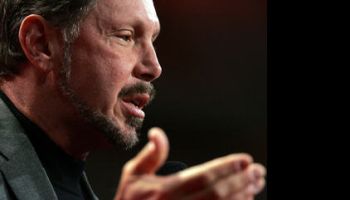New SPARC Cluster Is Oracle’s Challenge For HP And IBM

Oracle’s Larry Ellison took several jabs at one of his most formidable competitors – and this time his target was not IBM
Leave it to Larry Ellison, Oracle’s outspoken co-founder and CEO, to “spark up” what, at first, was looking like a pretty standard, no-nonsense product launch.
During Oracle’s introduction of a slew of new data centre products, the co-founder and CEO of the world’s second-largest, software-making company took several sort-of-playful jabs at one of his most formidable competitors – and this time it was not IBM.
Computers As Animals
 On stage at the 1940s-era auditorium on Sun Microsystems’ old Agnews campus, Ellison put up a series of slides showing how much faster he claims the latest Oracle Sun SPARC cluster is compared to IBM’s Power7 and Hewlett-Packard’s Itanium 2-based Superdome supercomputer clusters.
On stage at the 1940s-era auditorium on Sun Microsystems’ old Agnews campus, Ellison put up a series of slides showing how much faster he claims the latest Oracle Sun SPARC cluster is compared to IBM’s Power7 and Hewlett-Packard’s Itanium 2-based Superdome supercomputer clusters.
“If these computers were animals, what kind of animals would they be?” Ellison said in comparing benchmarked transaction processing speeds of each of those companies’ fastest systems.
As the ensuing slides came up – indicating Oracle’s Sun SPARC supercluster can perform at a whopping 30 million transactions per minute, IBM’s at 10 million per minute, and HP’s at four million per minute – Ellison slyly displayed pictures of a cheetah next to the Oracle logo, a racehorse next to IBM, and a turtle next to HP.
Laughs and giggles were heard from the standing-room-only audience of several hundred Oracle partners, customers, and staff members .
“So we’re one big cheetah, IBM’s a stallion, and HP’s a turtle,” Ellison said. “Make no mistake: We think the HP machines are slow, they’re vulnerable in the marketplace and we’re going to go after them with better hardware, better software, and better people.
“We’re going to win marketshare against those guys — in the database business, the middleware business, the server business and the storage business, because we have better products.”
Oracle, like most IT companies in co-operative/competitive situations, has a complicated relationship with HP. Prior to Oracle’s January 2010 acquisition of Sun, the two companies had worked together for years, selling into large clients in government, defence, scientific and other high-end IT systems.
However, now that Oracle is in the data centre hardware, software and services businesses – as well as the supercomputing business – with all of its Sun properties, that relationship with HP has become very strained, to say the least. Suffice to say that Oracle is not co-selling into large accounts anymore with HP providing its servers, storage, networking and services.
Still, there are a high number of HP-Oracle deployments in operation globally that require, and will continue to require for years, co-operation between the two companies, no matter how acrimonious the larger corporate relationship gets.
Ellison, as has been his modus operandi for years, is again going to great lengths to pooh-pooh his competitors and, now HP has eclipsed IBM, it is HP’s turn to receive the brunt of his criticism.
In fact, Ellison complimented IBM on its P7 cluster. A year ago, when he was bad-mouthing IBM at every opportunity, he never would have said: “IBM has a good product [with the P7]; what can I say? It has an excellent chip. They have smart guys working there, the PowerPC guys. But nonetheless, we beat them 3 to 1 in throughput and in better price/performance,” Ellison said.
“But the most shocking number of all is response time. We’re three times better in response time. Our [average] response time was less than half a second, for all these millions of transactions,” Ellison said.
SPARC-powered Exalogic cloud server
Oracle’s primary purpose at the conference was to announce a new Exalogic cloud computing system, powered by SPARC chips and running Solaris, to go alongside its Intel x86 version, demonstrated at OracleWorld in September.
The SPARC Exalogic is the new middleware platform for cloud systems; Exadata is the SPARC database server. Oracle is not shy about claiming that they are both the fastest in the world.
At OracleWorld, Ellison and chief hardware executive John Fowler showed the x86 Exalogic as a 30-server, 360-core system that companies can use to run their own private clouds in a single rack. This time, they showed two seven-foot-high SPARC racks, one Exadata and one Exalogic, on stage.
“We have been hearing about the ‘Sun-set’ and ‘Sun-down’ programmes for quite some time now but that’s hardly the case. There is also a book called ‘The Sun Also Rises,'” Ellison said. “We did our research and our theme is now called the ‘Sunrise’ programme.
“The mission-critical IT world still runs on Unix and Linux and Java: 10 of the top 10 banks, 10 of the top 10 telcos, and lots of others. SPARC Solaris and Java are still number one, as far as we can tell. 70 to 80 percent of our [database and server] business is Solaris and Linux-based, and we’re number two on both Windows and on IBM mainframes,” he boasted.